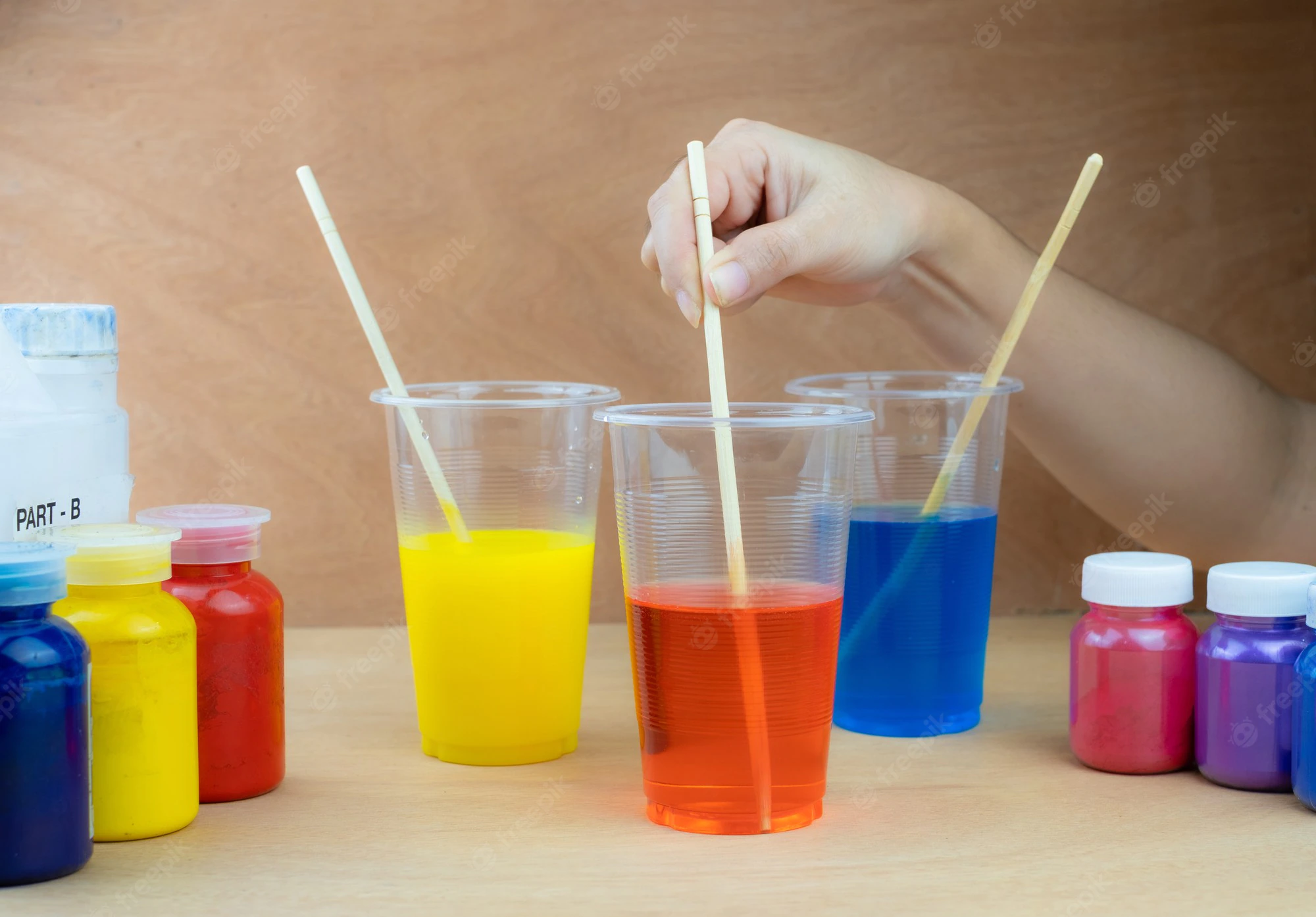As someone loves experimenting with acrylic paint with resin and getting something even better than i could get by just using one. But is it a safe mix? Can you mix acrylic paint with resin to make an exciting new composite medium?
You can also mix acrylic paints with resin by mixing them together on your palette. This will create a more transparent effect than just using an opaque medium on its own.
In this blog post, i will go through types of resin and why acrylic painters love working with resin as a medium.
Related Reading
Can You Use Acrylic Paint on Metal?
Can You Use Acrylic Paint on Glass?
Will Acrylic Paint Stick To Plastic?
Can You Use Acrylic Paint on Skin?
What is Resin?


Resin is a viscous substance secreted by many plants, especially conifers, and commonly used for the extraction of essential oils and other aromatic compounds. Resins are used in the manufacture of varnishes, adhesives and incense.
Resin consists of polymers of various biochemical compounds such as terpenes, sterols and polysaccharides. The individual components vary considerably and may include lignin, waxes or unsaturated hydrocarbons. A general term for resins can be defined as “any of a class of organic substances that largely consist of terpenes or terpenoid derivatives”.
Additionally, resins are organic substances that are soluble in alcohol and ether but not in water. Resins can be used to make things like varnish, paint, waxes and adhesives.
The Different Types of Resins and Their Uses
There are lots of different types of resins out there on the market. Here is a list of the most common resins used in everyday life and their uses.
1.Acrylic Resins
Acrylic resins are made from a polymerization reaction between an alcohol and an acrylic acid. This reaction occurs when the alcohol and acrylic acid are heated together in a reaction called esterification. The esterification process produces acrylic monomers, which are compounds that contain only one stereo center (carbon-oxygen double bond). These compounds then react with other monomers to form polymers. Acrylic resins are made by polymerizing these monomers in water or an organic solvent such as alcohol or acetone.
Acrylics have many uses because they can be made into any shape or size, they’re easy to color and they can be transparent or opaque depending on the thickness of the resin film. Acrylics can also be used as adhesives, coatings and sealers if they’re thin enough not to interfere with light transmission through them.
2.Epoxy Resins
Epoxy resins are made of two parts: an epoxide resin and a hardener. The epoxide resin is the base material, which is mixed with a hardener to create a solid plastic called an epoxy.
Epoxy resins can be used to bond metals, ceramics and many other materials. They are also used in paints and coatings because they can be applied over a wide range of surface temperatures. Epoxies are often used in dental work because of their ability to withstand high heat and acid conditions.
3.Polyester Resins
Polyester resins are used in the production of fiberglass, which is a material that is used in boat construction, airplane construction and many other products. Polyester resins have good thermal stability and can be used at high temperatures. The process of producing fiberglass involves dissolving polyester resin in water and then adding it to chopped fiberglass. The mixture is heated and sprayed onto a cloth that is stretched over the mold or object to be produced.
Polyester resins are also used in casting applications for both metals and plastics. They are often used as binders for phenolic composites and epoxy resins. They can also be used as adhesives for gluing parts together or for coating surfaces before painting them with other materials.
4.Silicone Resins
Silicone resins are the most commonly used type of silicone. They are available in both liquid and powder form. The liquid resin is mixed with a catalyst (typically platinum) to produce a solid cure. Silicone powder is mixed with a catalyst, which is then added to water to produce a liquid cure.
Silicone resins are also typically used for casting and mold making applications. They will not cure in the presence of moisture or oxygen, so they can be used as potting compounds or encapsulation materials.
Can You Mix Acrylic Paint With Resin?
You can mix acrylic paint with epoxy resin. If you’ve ever worked with epoxy resin before, you know how finicky it can be. You have to mix the components exactly right or else the result will not cure properly or at all — or worse yet, will cure with bubbles or other defects in it. The same thing goes for mixing acrylic paint with epoxy resin: if you don’t do it correctly, your project won’t work out well at all.
How to Mix Acrylic Paint With Resin?
The best part about mixing acrylic paint with resin is that it’s very easy to do! You just need a few simple supplies and you’re ready to go:
What You’ll Need
- Resin
- Acrylic Paint
- cup/container
- Hardener
- Wooden Sticks
- Hit gun
Instructions
- Pour the resin in a cup and add a hardener. The amount of hardener needed depends on your project. If you’re working with small amounts, you may not even need any at all. Mix till the solution is not too sticky and too thin.
- Add acrylic paint and mix well.
- Paint with this mixture on your canvas or any other surface that you want to color in different colors.
- Cure with a hit gun
Tips for Mixing Acrylic Paint with Resin
1.Prepare Your Surface
The first thing you should do is prepare your surface. You can use any number of different types of surfaces for mixing resins with acrylic paint. Some examples include canvas, paper or wood panels. The key is to make sure the surface is clean and free from contaminants such as dust or dirt.
2.Consider the Color of Your Resin
The first step in learning how to mix acrylic paint with resin is determining which type of resin you would like to use. If you want your piece to have an opaque finish, choose one that has an opaque color such as white or black. If you prefer a translucent or transparent look, select an opaque-colored resin that has sparkles or glitter added to it such as gold or silver.
3.Mixing Ratio
Most people use 1-1 ratio. However, Mixing acrylic paint with resin up to 10% of the volume of the mixture is far more better. Adding any more than that makes the resin cloudy or prevents it from curing properly.
4.Get Rid of Air Bubbles
Air bubbles are a common problem with resin. The resin is clear and we can’t see them until the piece has cured, but they are there. To get rid of air bubbles, you need to mix your acrylic paint with the resin in small batches. This will allow you to be more accurate with your measurements and also stop air bubbles from forming in the first place.
Also, you can get rid of air bubbles with hair dryer
Mixing Acrylic Paint With Epoxy Resin
Mixing acrylic paint with epoxy resin is a great way to create a durable finish for your project that looks like oil paint. The two products mix together easily, and you can use acrylics in any color you want. The resin will add a glossy sheen to your paint, but the mixture will still be fairly translucent.
How to Mix Acrylic Paint With Epoxy Resin?
- Mix equal parts of the two products in a disposable container such as a plastic cup or paper plate.
- Stir until they are thoroughly blended together. This may take a few minutes if you are using an electric drill.
- Pour the mixture onto your project surface and spread it evenly with an artist’s brush or other suitable tool. You should see an even coat of mixture covering your project within seconds of applying it.
What Else Can You mix with epoxy resin?
Epoxy resin is a two-part epoxide resin that cures to a clear, hard, high-gloss finish. You can mix it with other mediums to create your own custom colors and effects.
1.Acrylic Ink
Mixing acrylic ink with epoxy resin will give you a paintable finish for your project. Use this method for making faux stained glass or other designs that require layering colors.
2.Eye Shadow
You can use eye shadow as a pigment or pigment extender in your epoxy resin projects. It’s great for adding shimmer to the surface of your design.
You can find eye shadow at the drugstore or at Walmart, Target and other discount stores. The colors you choose will depend on what you want to achieve with your design. For a pearlized look, try mixing equal parts eye shadow and epoxy resin. For example, mix one drop of blue eye shadow with one drop of clear epoxy resin and stir well until blended. Then add another drop of clear epoxy resin and stir again until blended. Repeat this process until you have achieved your desired color intensity.
To create a glittery effect, try mixing equal parts eye shadow and epoxy resin together in a small container (such as an old pill bottle). Stir well until blended then pour into your mold cavities using a small funnel or spoon.
3.Nail Polish
Adding nail polish to the mix will make your finished project more durable, but it will also give it more color options than just plain clear finishes. If you’re trying to match existing colors in your room, try mixing in some of the same shade of nail polish as an accent color on your piece. Be sure not to use too much though; too much polish can cause bubbles and other problems during curing time.
4.Alcohol Ink
Alcohol ink is similar to acrylic ink in that it’s a paintable medium that can be mixed with epoxy resin to create unique effects like faux stained glass or watercolor.
The difference between alcohol ink and acrylic paint is that alcohol ink dries quickly, which means it’s perfect for creating interesting textures and layers. You can also use it as an alternative to glitter if you want something shinier than regular paint. Alcohol ink comes in many colors, so you can easily experiment with mixing them together for different effects!
5.Glitter
Glitter is a form of cosmetic makeup that is used to provide a shiny effect. The term “glitter” is used to describe the small, reflective pieces of metallic or non-metallic material which are applied over another surface and adhere temporarily to it.
Glitter can be added to epoxy resin in a couple of different ways. You can buy glitter from a craft store and mix it into your epoxy resin before you pour it into the mold. This works well because you have more control over how much glitter gets mixed in with your resin. Or you could use loose glitter and add it after pouring your epoxy resin into its final container.
Curing Time
The curing time for resin is about 24 hours. The actual time it takes for a piece to cure depends on the temperature and humidity level of your room . If you want to speed up the process, you can use a blow dryer or heat gun to speed up the process.
Frequently Asked Questions
What happens if you mix acrylic paint with epoxy resin?
Acrylic paint can be mixed with epoxy resin. They are both plastic, so they will not react with each other. Epoxy will harden the acrylic paint, but it will also make it less flexible and transparent.
Does resin react with acrylic?
Resin will stick to acrylic, but you need to sand the acrylic first. Acrylic is a plastic and resin is a hardener. You can’t just adhere them together without applying some kind of adhesive between them.
Conclusion
Mixing acrylic paint and resin might seem unlikely, but when you think about it, there’s no real reason why your paints and resin can’t mix together. If you want to create a design with a unique coloration, then mixing up your acrylic paints with resin might just be the way to go..
SOURCES
Is it safe to work with epoxy resin and acrylic paints?
https://www.quora.com/Is-it-safe-to-work-with-epoxy-resin-and-acrylic-paints
Why is my acrylic paint not mixing well with epoxy
https://en.wikipedia.org/wiki/Acrylic_paint
Can I mix acrylic paints into resin?






